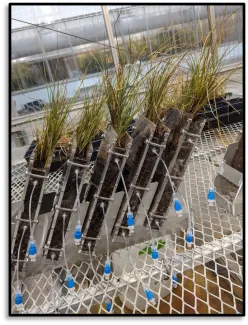We are conducting a greenhouse experiment with live Arctic thermokarst wetland vegetation to pinpoint important biogeochemical processes in these changing ecosystems.
Permafrost soils contain at least one third of the planet’s soil carbon and act as a net sink for CO2 due to the cold and wet conditions in the Arctic, but these ecosystems and their carbon cycle are being altered by climate change and warming. These concerns are backed up by many soil incubations showing increased carbon release with warming. While these studies show how soil respiration may change with warming, laboratory-based experiments often exclude plant-soil interactions, particularly plants that grow in thermokarsting areas such as thermokarst wetlands. We are therefore conducting a 2.5-month long mesocosm experiment using rhizoboxes with and without live thermokarst wetland graminoids collected from the Council, Alaska field site. Our overarching objective is to better understand how graminoids growing in these thermokarst wetlands alter belowground biogeochemistry and affect plant-soil interactions and fluxes of greenhouse gasses (CO2, CH4, N2O). We hypothesize that these graminoids produce low molecular weight dissolved organic carbon (DOC) in the porewater, helping feed methanogenesis, while their aerenchyma likely play a role in methane and oxygen transport to the rhizosphere. Our preliminary findings indicate distinguishable changes in soil chemistry between rhizoboxes with and without graminoids. Rhizoboxes with graminoids have significantly (P <0.05) lower molecular weight DOC in the porewater compared to rhizoboxes with no plants, supporting our hypothesis about the feedback between molecular weight and methanogenesis. We also measured significantly higher soil redox conditions in the rhizoboxes with graminoids which could be evidence for oxygen transport belowground through the plant’s aerenchyma. These preliminary results indicate that vegetation alters belowground biogeochemistry, likely altering the soil carbon cycle in these changing ecosystems.
For more information, please contact:
Verity Salmon
salmonvg@ornl.gov

